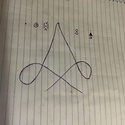Simple Buck Converter
Featured
97
Favorite
944
Copy
175122
Views
Circuit Description

Circuit Graph
This circuit illustrates the basic operation of a DC-DC step down buck circuit. The diode and transistor elements are modeled using ON/OFF resistances. These elements help focus attention on other salient variables in circuit: duty cycle, L, C, parasitic resistances, and load current. The circuit provides a great way to understand some of the behaviors of this very important topology.
Run the simulation. The circuit is configured to provide 5V.
1. Adjust the value of the capacitor C1. What is the affect on the output voltage ripple?
2. Slowly adjust the R_load resistor to change the load current.
Does the output always remain at 5V? Observe the inductor current carefully
3. Slowly adjust the value of the inductor. What is the effect?
4. How does the capacitors ESR (Equivalent Series Resistors) impact the output?
This parasitic resistor can be quite significant in the real world.
Private Copy
Private Copy
Private Copy
Private Copy
Private Copy
Private Copy
Private Copy
Private Copy
Private Copy
Private Copy
Private Copy
Private Copy
Private Copy
Private Copy
Private Copy
Private Copy
Private Copy
Private Copy
Private Copy
Private Copy
Private Copy
Private Copy
Private Copy
Private Copy
Private Copy
Private Copy
Private Copy
Private Copy
Private Copy
Private Copy
Private Copy
Private Copy
Creator
OStep
3 Circuits
Date Created
9 years, 3 months ago
Last Modified
9 years, 3 months ago
Tags
Open Circuit
✕Circuit Graph
✕







































pablohernandez says:
zulkharnain says:
yahrin310 says:
Ngongo says:
Heeft iemand hier een counter al gemaakt, dat zal ik graag naar willen kijken?
groet, Ngo
rikilulululu says:
M0tasem says:
a7md_77 says:
Dragonslayer-579 says:
FishLove0910 says:
schmizpierre says:
KageTheG says:
bellia.lorenzo says:
Comment has been removed
RA2111033010051 says:
Comment has been removed
RA2111033010039 says:
Comment has been removed
Sapobully4L says:
Siamo il giro baby, la mia casa è bianca (White)
Ma non è la Casa Bianca
Ollare, ollare, ollare, ollare, ollare, white in tasca (Rrrrah)
Braccialetto al piede (Ah?)
Capta segnali
Il mio amico è dentro
Cerca di mordersi la coda come i cani
Faccio tu-tu .44 Magnum, non è un gelato (Ah?)
Nuove Nike, cammino male (Ollare gang)
Non sparo con scacciacani
FSK, the real trapshit (Ollare ollare ollare gang)
TEHRANGELES⚡ says:
I like how you added the ESR resistors for the capacitor and inductor to mimic what would happen in real life.
user-1089228 says:
user-1089228 says:
Comment has been removed